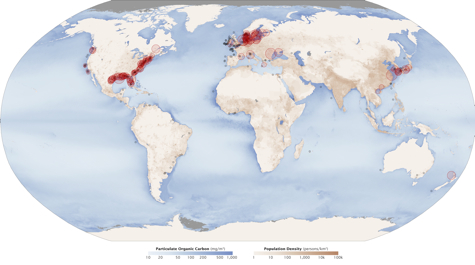NASA map uses VIMS data on low-oxygen dead zones
A new global map created by NASA uses data from Professor Bob Diaz of the Virginia Institute of Marine Science to highlight the connection between human population density, nutrient pollution, and low-oxygen marine "dead zones."
The map was featured as the "Image of the Day" for July 17 on NASA's Earth Observatory website. The Earth Observatory site, winner of multiple Webby Awards, is produced at NASA's Goddard Space Flight Center in Greenbelt, Maryland. "Webbys" are the leading international award for excellence on the Internet.
Created by Goddard scientists Robert Simmon & Jesse Allen, the map combines Diaz's dead-zone data with measurements of human population density and particulate organic carbon in marine waters. The population data were supplied by Columbia University's Socioeconomic Data and Applications Center. Data on particulate organic carbon, an indicator of ocean fertility, are from Goddard's Ocean Color team and based on measurements from the MODIS instrument aboard the Aqua satellite. MODIS stands for Moderate Resolution Imaging Spectroradiometer.
Diaz began studying "dead zones"—areas of seafloor with too little oxygen for most marine life—in the mid 1980s after seeing their effect on bottom life in the Patapsco River near Baltimore. His first review of dead zones in 1995 counted 305 worldwide. That was up from his count of 162 in the 1980s, 87 in the 1970s, and 49 in the 1960s. He first found scientific reports of dead zones in the 1910s, when there were 4. Worldwide, the number of dead zones has approximately doubled each decade since the 1960s.
Diaz's data shows that the number of dead zones has increased by a third between 1995 and 2007. Dead zones are now a key stressor of marine ecosystems and rank with over-fishing, habitat loss, and harmful algal blooms as global environmental problems.
Diaz and collaborator Rutger Rosenberg of the University of Gothenburg in Sweden record 405 dead zones in coastal waters worldwide, affecting an area of 95,000 square miles, about the size of New Zealand. The largest dead zone in the U.S., at the mouth of the Mississippi, covers more than 8,500 square miles, roughly the size of New Jersey. A dead zone also underlies much of the main-stem of Chesapeake Bay, each summer occupying about 40% of its area and up to 5% of its volume.
Users can access Diaz's dead zone data within the newest version of Google Earth by opening the "Layers" pane and navigating to Ocean/State of the Ocean/Dead Zones. The program can be downloaded for free by browsing to http://earth.google.com/ocean. Each dead-zone location in Google Earth (marked by a skeletal fish icon) includes data on the nature of the dead zone (periodic, seasonal, or persistent), its size, the date it was first observed, its impact on fisheries, its impact on deep-water ecosystems, and a reference.


